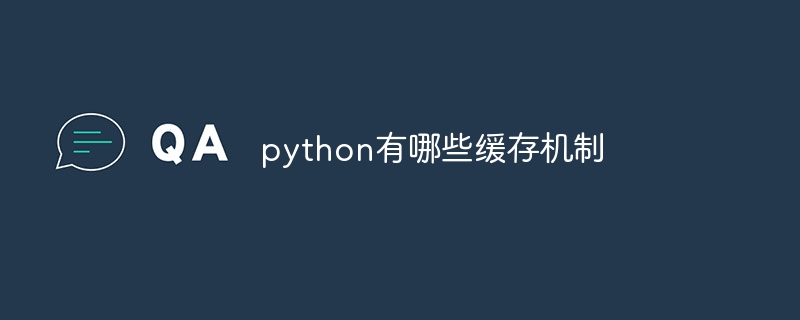Home >Backend Development >Python Tutorial >What caching mechanisms does python have?
What caching mechanisms does python have?
- 百草Original
- 2023-11-16 11:02:071481browse
What caching mechanisms does Python have? Memory cache, data structure cache, cache decorator, object proxy cache, cache library, distributed cache, cache strategy, cache invalidation mechanism, compression and encoding, etc. Detailed introduction: 1. Memory cache, Python's memory management mechanism will automatically cache frequently used objects to reduce the cost of memory allocation and garbage collection; 2. Data structure cache, Python's built-in data structures, such as lists, tuples and dictionaries. , has an efficient caching mechanism; 3. Cache decorator, Python decorator, etc.

The operating system for this tutorial: Windows 10 system, Python version 3.11.4, DELL G3 computer.
As a high-level programming language, Python provides a variety of caching mechanisms to improve performance and response speed. The following are the main contents of the Python caching mechanism:
1. Memory cache: Python's memory management mechanism automatically caches frequently used objects to reduce the cost of memory allocation and garbage collection. When an object is used frequently, Python stores it in memory so that subsequent requests can obtain the object more quickly. This caching mechanism is automatic and developers do not need to write caching code explicitly.
2. Data structure caching: Python’s built-in data structures, such as lists, tuples and dicts, have efficient caching mechanisms. When a list, tuple, or dictionary is modified, Python creates a new object and points a reference to the original object to the new object. In this way, modifications to the list, tuple, or dictionary will not affect the reference of the original object, thus achieving the cache effect.
3. Cache decorator: Python's decorator can be used to wrap functions or methods to add additional functionality or behavior. Using the cache decorator, the output of a function can be cached so that the cached result can be returned directly the next time it is called. Common cache decorators include functools.lru_cache and cachetools.cached.
4. Object proxy caching: Python can implement caching through object proxy. An object proxy is a class that wraps another object and is responsible for managing and caching that object's properties. When the attribute is accessed, if the attribute is already in the cache, the cached result is returned directly; otherwise, the value of the attribute is calculated and cached. This approach reduces double calculations and unnecessary memory allocations.
5. Cache library: Python has many third-party libraries that can be used to implement caching functions, such as Beaker, Cachetools and PyMemcache. These libraries provide more flexibility and extensibility and can be customized according to specific needs. They usually support multiple caching strategies, such as LRU (least recently used), LFU (least frequently used), etc.
6. Distributed cache: For large applications or distributed systems, distributed cache may be needed to improve scalability and fault tolerance. Distributed caching caches data on multiple nodes so that cached data can be shared among multiple servers. Common distributed caching solutions include Redis, Memcached, Cassandra, etc.
7. Caching strategy: Different caching strategies can be selected according to different application requirements and scenarios. Common caching strategies include least recently used (LRU), least frequently used (LFU), etc. These policies can determine which entries should be replaced or eliminated based on factors such as frequency of access, resource size, resource type, and more.
8. Cache invalidation mechanism: The data in the cache may become invalid due to various reasons, such as data update, expiration time, etc. In order to ensure cache consistency, a cache invalidation mechanism needs to be used to handle invalid situations. Common failure mechanisms include timing failure, counter failure, condition failure, etc.
9. Compression and encoding: For large data or network transmission, you can consider compressing and encoding the data to reduce the transmission volume and network bandwidth consumption. Python provides a variety of compression and encoding libraries, such as gzip, bz2, zlib, etc. At the same time, the client can also decode and decompress the response for local use.
To sum up, Python provides a variety of caching mechanisms to improve performance and response speed. These mechanisms include memory cache, data structure cache, cache decorator, object proxy cache, cache library, distributed cache, cache strategy, cache invalidation mechanism, compression and encoding, etc. Choosing an appropriate caching mechanism based on specific business needs and scenarios can help developers optimize the performance and response speed of Python applications.
The above is the detailed content of What caching mechanisms does python have?. For more information, please follow other related articles on the PHP Chinese website!

